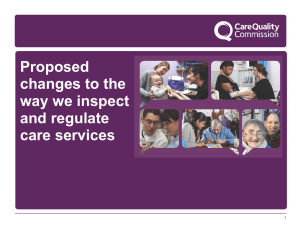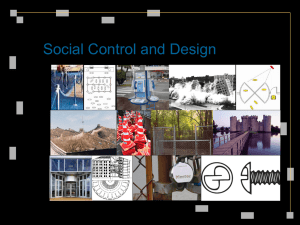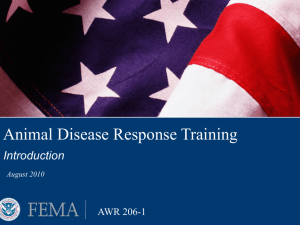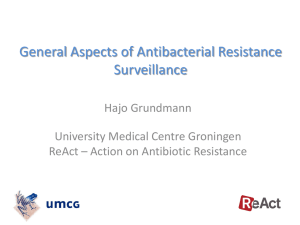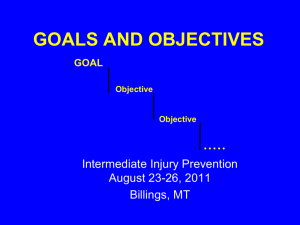Public Health Surveillance - Council of State and Territorial
advertisement
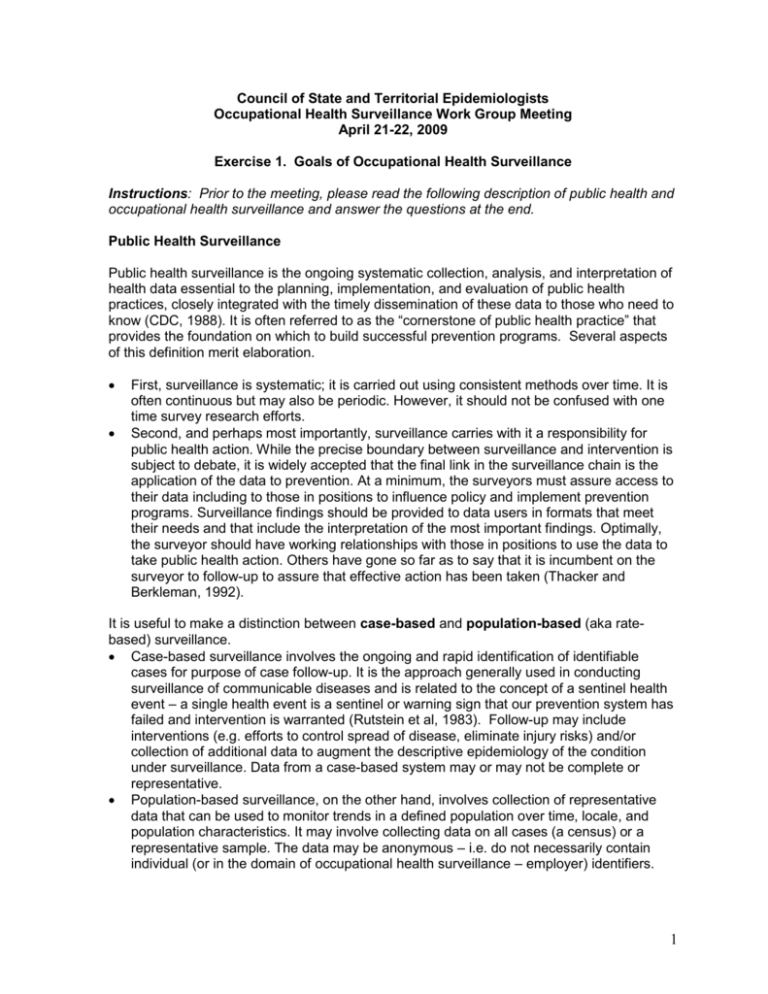
Council of State and Territorial Epidemiologists Occupational Health Surveillance Work Group Meeting April 21-22, 2009 Exercise 1. Goals of Occupational Health Surveillance Instructions: Prior to the meeting, please read the following description of public health and occupational health surveillance and answer the questions at the end. Public Health Surveillance Public health surveillance is the ongoing systematic collection, analysis, and interpretation of health data essential to the planning, implementation, and evaluation of public health practices, closely integrated with the timely dissemination of these data to those who need to know (CDC, 1988). It is often referred to as the “cornerstone of public health practice” that provides the foundation on which to build successful prevention programs. Several aspects of this definition merit elaboration. First, surveillance is systematic; it is carried out using consistent methods over time. It is often continuous but may also be periodic. However, it should not be confused with one time survey research efforts. Second, and perhaps most importantly, surveillance carries with it a responsibility for public health action. While the precise boundary between surveillance and intervention is subject to debate, it is widely accepted that the final link in the surveillance chain is the application of the data to prevention. At a minimum, the surveyors must assure access to their data including to those in positions to influence policy and implement prevention programs. Surveillance findings should be provided to data users in formats that meet their needs and that include the interpretation of the most important findings. Optimally, the surveyor should have working relationships with those in positions to use the data to take public health action. Others have gone so far as to say that it is incumbent on the surveyor to follow-up to assure that effective action has been taken (Thacker and Berkleman, 1992). It is useful to make a distinction between case-based and population-based (aka ratebased) surveillance. Case-based surveillance involves the ongoing and rapid identification of identifiable cases for purpose of case follow-up. It is the approach generally used in conducting surveillance of communicable diseases and is related to the concept of a sentinel health event – a single health event is a sentinel or warning sign that our prevention system has failed and intervention is warranted (Rutstein et al, 1983). Follow-up may include interventions (e.g. efforts to control spread of disease, eliminate injury risks) and/or collection of additional data to augment the descriptive epidemiology of the condition under surveillance. Data from a case-based system may or may not be complete or representative. Population-based surveillance, on the other hand, involves collection of representative data that can be used to monitor trends in a defined population over time, locale, and population characteristics. It may involve collecting data on all cases (a census) or a representative sample. The data may be anonymous – i.e. do not necessarily contain individual (or in the domain of occupational health surveillance – employer) identifiers. 1 Case- and population-based approaches to surveillance are not mutually exclusive. Many conducting surveillance at the state level have found that the most useful surveillance systems have attributes of both. These systems can be used to identify sentinel cases for follow-up and, at the same time, generate representative summary data to guide broader based prevention efforts. Arguably, it the combination of case reports (. the stories) and statistics that is often most compelling in influencing public health policy (Derickson, 1992). Occupational Health Surveillance Public health surveillance by definition involves the collection of “health data.” In the domain of occupational health, surveillance may involve collecting data on either or both work-related health outcomes, such as work-related injuries, illnesses or deaths, or health and safety hazards, such as exposures to hazardous chemicals or the presence of unguarded equipment. Hazard surveillance is optimal because it involves the identification of risks before injuries or illnesses occur – thereby allowing for primary prevention. In the U.S., however, hazard surveillance efforts are generally quite limited.1 It is also possible to conduct surveillance of interventions (i.e. corporate or worker health and safety behaviors), but systems are not currently in place to track health and safety interventions in the U.S.2 The existing national and state occupational health surveillance systems center on collecting data on adverse occupational health outcomes. (Information about hazards associated with these outcomes may also be collected.) Goals of Tracking Work-related Injuries and Illnesses Information about where and how workers are injured or made ill on the job is essential to target, design and evaluate prevention efforts, ranging from regulatory and educational activities to the development of new safer technologies and public policies to promote safe and healthful work. Surveillance provides this information, allowing us to set priorities for allocation of limited prevention resources, to design relevant interventions, and to monitor progress in meeting injury and illness reduction goals. Surveillance can also play a critical role in mobilizing action to address the workplace health and safety problems. Surveillance is important at both the national and state levels. National data are essential to inform national prevention priorities and programs. However relying on national statistics can obscure dangers that may be specific to a particular state. States are also in a position to link surveillance findings with interventions at the state and local levels. State data can identify the specific occupations, industries and communities in which workplace hazards need to be addressed. In addition, state surveillance systems can pinpoint specific workplaces in which workers are at risk and intervention is necessary. Publication of state data and case reports can also be a powerful means of attracting the attention and gaining support of local policy makers and the public. Surveillance at the worksite itself is a crucial component of a comprehensive worksite health and safety program. In short, the potential goals of conducting surveillance of work-related injuries and illnesses are many (see box below) and vary according to surveillance system and geographic area or locale under surveillance. 1 The OSHA IMIS data base for air sample results and the CDC analysis of chemicals and metals from a sample of the general population are examples of hazard surveillance. 2 The use of respirators or presence of worksite health and safety programs are examples of interventions that could be tracked. 2 Goals of Tracking Work-related Injuries and Illnesses To document the overall magnitude of the problem. How many workers are injured/ill? At what rate? How severe are the injuries and illnesses? Are trends increasing or decreasing? To identify the industries and occupations where intervention is most needed. What industries and occupations have the highest injury rates? The highest numbers of injuries/illnesses? The most severe injuries/illnesses? To characterize the populations (defined by age, gender, race/ethnicity) at risk that merit special attention. Are there occupational health disparities among population groups? To characterize the most common types of injuries/illnesses, their causes and known risk factors that need to be addressed. To identify potential, previously undocumented risk factors (e.g. inadequate supervision) that require further etiologic research. To identify new or emerging hazards (new hazards; old hazards in new settings). To identify individual worksites (establishments/departments within workplaces) where intervention is warranted. To evaluate the effectiveness of intervention efforts. To mobilize support for prevention activities. Questions: 1. Are there additional goals of surveillance that should be added to this list? Please specify. 2. From your perspective as a representative of labor, industry, federal government, state government, academia, please rank the goals in order of importance. 3. Consider one occupational illness or injury surveillance system that you are familiar with and ask yourself how well it does in meeting surveillance goals. See next page. 3 Name of System: Goal Performance Determine magnitude Prioritize industry/occupations ID priority populations Prioritize known hazards Generate hypotheses about new risks ID new/emerging hazards Target worksite/department Evaluate interventions Mobilize support References (CDC) Centers for Disease Control. January (1988). CDC Surveillance Update. Atlanta, GA: CDC. Council of State and Territorial Epidemiologists: The Role of the States in a Nationwide, Comprehensive Surv eillance System for Work-related Diseases, Injuries and Hazards, 2001. Derickson A: Making human junk: Child labor as a health issue in the progressive era. Am J Public Health, 1992; 92 (9), 1280-1290. Rutstein DD, Mullan R, Frazier, T. Halperin W, Melius I, Sestito: Sentinel health events (occupational): A basis for physician recognition and public surveillance. Am J Public Health, 1983;73, 1054-106. Thacker S and Berkleman R: History of public health surveillance, in Public Health Surveillance, W. Halperin and E Baker eds. Van Nostrand Reinhold, New York, New York, 1992. 4
